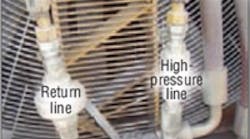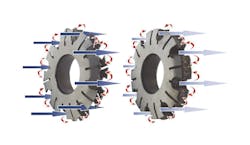All hydraulic fluid, lubricating oil, and coolant in Caterpillar heavy equipment pass through barrier-type filters designed to remove solid contamination. These filters are excellent at removing contaminants larger than the smallest pores in the filter. However, these fluids also contain very small, shards of ferrous metal so small that they can pass through filter media and attack pumps, valves, cylinders, and other critical components used in Caterpillar's heavy equipment.
Whayne Supply Co., Louisville, Ky., is the largest Caterpillar dealer in North America. Edwin Downer, general manager of Whayne’s Technology Div., and his colleagues were looking for ways to remove these troublesome contaminants. After meeting with representatives from Magnom at ConExpo, Whayne officials considered Magnom’s Core Technology as a potential solution to ongoing premature system wear and costs associated with frequent maintenance and repairs caused by contaminated fluids.
Initial testing
Downer said the first step was to validate Magnom’s technology to determine its effectiveness. (See the end of this article for a description of the technology.) The turbocharger drain line on a Caterpillar 3406 E was selected for this initial testing. A Magnom Midi inline unit was installed downstream of the system’s normal barrier filter, which was rated to remove all solid contaminants larger than 5 μm.
After two months of normal operation, the Midi unit was removed and its core examined. The core had collected a significant amount of small metal particles down to sub-micron size that had passed through the system’s barrier filter. This test validated two important points for Downer. First, the existing filter system, while providing excellent filtration of contaminants larger than 5 μm, was allowing a significant amount of smaller particles to pass through. Second, the Magnom Core was efficiently removing these small metal particles.
The results also showed the need for additional testing to determine if removing these small particles would improve system life and reduce maintenance costs. If so, could a custom housing be designed to allow quick and easy installation on the Caterpillar equipment?
Opposites attract, likes repel
The technology developed by Magnom removes sub-micron and larger sized contaminants from hydraulic fluid using a combination of magnets and specially formed steel plates to collect the ferrous particles. Housed around central magnets, the steel plates transmit magnetic fields that attract ferrous and other magnetically sensitive particles into collection zones between the plates.
The plates are arranged as positive-negative pairs, and because opposite charges attract, positively charged particles are drawn into negatively charged collection zones formed between pairs of plates. Likewise, negatively charged particles are drawn into positively charged collection zones. Because ferrous particles tend to hold a positive or negative charge, they will be attracted either to a negative or positive collection zone.
Furthermore, flow pulses and surges — inherent to most hydraulic systems — do not dislodge the particles from the collection zones because trapped particles are not in the main stream of fluid flow. Moreover, magnetic forces (opposite charges) hold particles within the collection zones. For the particles to exit the collection zones, they would have to overcome the magnetic force of a pair of like-charged plates. In essence, then, the particles are held in place by the attraction of opposite charges and the repulsive force of like charges.
The hard, small particles of ferrous metals typically found in hydraulic systems are too small to be trapped by even the finest mediatype filters. Furthermore, these particles typically have sharp edges and are dense, so they can tear the media when they pass through the filter, shortening media life. Removing these contaminants interrupts the chain reaction of wear to extend the life of components within the system and improve reliability.
Unlike media filters, Magnom cores do not create an increasingly high pressure drop as more contamination collects. This is because particles collect in areas removed from flow paths. In fact, pressure drop is not a factor when applying Magnom cores. The cores are sized so that the flow area around all the steel plates equals or exceeds the flow area of inlet and outlet ports.
As noted already, Magnom cores should not be used to replace conventional, media type filters. Instead, they improve system filtration and extend the life of media filters. They do this by trapping particles that would otherwise collect in filter elements, and they remove the hardest, most damaging particles from the flow stream. And unlike ultra-fine media filters, electrostatic fluid cleaners, and centrifuges, they provide a simple and inexpensive technique to maintain higher fluid cleanliness.
Further testing
Whayne officials next chose to test the hydraulic fan drive system on Cat D11 R tractors. These machines operate 20 hr/day, 7 days a week, with an average life of about 4000 hr for the fan drives. Two systems were selected for the test, and Magnom inline units were installed on high-pressure and return lines connecting the hydraulic power unit to the fan drive. After 15,000 hr in service, the fan drive system on the first D11 finally required service. Installing the Magnom units extended the service life to almost four times the average, saving the costs otherwise associated with three fan drive failure repairs.
Typical service costs associated with a fan drive failure were estimated at $22,000 per event, so the total savings was calculated at $66,000. Installation costs for the Magnom units totaled less than $1,000, and at the time of this writing, the fan drive in the second D11 was still operating. Downer said he believes the testing revealed the benefits derived from adding Magnom units to conventional filter systems. “The combination of a traditional barrier filter and the Magnom Core technology provides an enhanced filter system with high efficiency, lower system operating costs, and higher equipment performance.”
Taking it a step further
Whayne and Magnom officials also began a program to design a product that would allow technicians to quickly install Magnom units on existing equipment. Objectives were that the units would:
- be easy to install and service in the field,
- not require significant modification to existing systems,
- withstand the demands of the severe working conditions normally experienced by Cat equipment, and
- exhibit low cost.
Magnom had already developed a housing for installing the magnetic cores between an engine and spin-on filter, so this concept was repeated to meet the design criteria identified by Whayne. The sandwich configuration was modified to eventually become the Whayne Pre- Filter Unit (PFU).
Whayne and Magnom later modified the design to include safety and easeof- use features, such as eliminating any risk of incorrectly installing the PFU and adding structural strength to the design and increasing mounting and attachment options. Whayne installed units on a fleet of Cat 330 rental units that had been fitted with hydraulic hammers — among the most punishing applications in all of mobile hydraulics. Installing the inline units on the high and low pressure lines connecting the hammer to the host unit reaps two benefits. First, the Magnom units protect the main hydraulic system of the Cat 330 by removing any contamination generated in the hammer. Second, the Magnom units prevent cross contamination. Tools and host machines used by Whayne customers are paired in any number of combinations. If any of the component contains high contamination, adding Magnom units to the system prevents an “infected” component from passing the contamination on to the host machine’s hydraulic system.
Whayne formed a Technology Division to market these innovative products to reduce customers’ equipment operating costs. Whayne also provides the products to their extensive fleet of rental equipment, their in-house fleet of service and transport trucks, and other Caterpillar dealers.
For more information on Magnom magnetic filters, visit www.magnom.com.
For more information from Whayne Supply Co., visit www.whayne.com.
This article appeared in print as "To Catch a Thief" in the September 2011 issue.



